 Image search results - "japaneki" Image search results - "japaneki" |
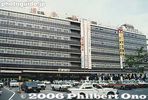
Hakata Station, gateway to Kyushu
|
|
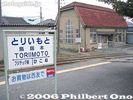
Although the Honjin is long gone, there are a few reminders of its shukuba past. Near Ohmi Railways Toriimoto Station. Map
|
|
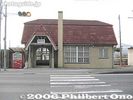
Toriimoto Station building built in 1931 when the station opened and still in use.
|
|

Kusatsu-juku was the fifty-second station on the Tokaido Road (following Ishibe-juku) and the sixty-eighth station (following Moriyama-juku) on the Nakasendo Road. During the Edo Period, Kusatsu was an important post town at the crossroads of both roads.The roof is shaped like a Honjin lodge, with a gate. 草津駅
|
|

Ohmi Railways Toyosato Station. MAP
|
|

Kyoto Station
|
|

Chiba Koen Station 千葉公園駅
|
|

Iyo-Hojo Station
|
|
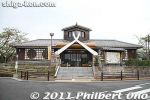
Held only once every five years, the Aburahi Festival with the yakko-furi procession was held by Aburahi Shrine in Koka, Shiga Prefecture, Japan on May 1, 2011.The procession features yakko samurai laborers who carry a trunk and sing. Others also dance. The procession makes a circular route near Aburahi and Koka Stations on the JR Kusatsu Line. Aburahi Station on the JR Kusatsu Line. Very nice design.
|
|
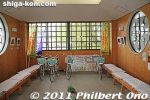
Rental bicycles at Aburahi Station's waiting room. The round windows have a ninja shuriken throwing knife design.
|
|

Cable Enryakuji Station. This is the original Cable Enryakuji Station building that was used when the cable railway between Sakamoto and Mt. Hiei opened in 1927.It was Japan's longest cable car route (2025 meters) at the time. The first floor is the station, while the 2nd floor used to be a VIP room. The 2nd floor is now an exhibition hall and open to the public.
|
|

Notogawa Station on JR Tokaido/Biwako Line. Beautifully designed station resembling a water wheel, the symbol of the town. East Exit. 能登川駅
|
|

Notogawa Station, West Exit, also designed as a water wheel. This is one of Shiga's best-designed train stations. Beautifully designed station resembling a water wheel, the symbol of the town.
|
|
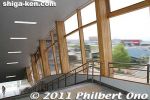
Inside Notogawa Station. The waterwheel structure houses a stairway and escalator.
|
|

Ueno-shi Station
|
|

JR Kanazawa Station's Tsuzumi Mon gate. JR金沢駅 鼓門
|
|

Kaminoyama Onsen Station is the closest train station to Kaminoyama Castle. The station building is obviously designed after the castle.
|
|

Kaminoyama Onsen Station used to be called Kaminoyama Station. The station's name was changed to Kaminoyama Onsen after the Yamagata Shinkansen was completed in 1992. This building was completed in June 1994.
|
|

Even the police box (koban) near the Kaminoyama Onsen train station is designed after the castle.
|
|
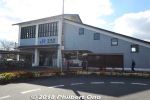
JR Koka Station on the JR Kusatsu Line opened its new station building in Nov. 2005. Resembling a farmer's warehouse on the outside, the inside has a number of surprises. MAPNorth side
|
|

Ninja statue in front of JR Koka Station, Shiga Prefecture.
|
|
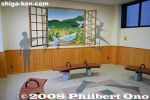
On the north side, the waiting room has this large painting. The shadow areas is where you can stand and pose for a picture.
|
|
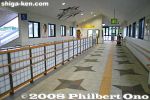
Koka Station's 2nd floor corridor has shuriken (ninja throwing knives) design on the floor.
|
|

Ceiling painting of ninja appearing from a cloak. You can have someone "touch" the tip of the cloak.
|
|
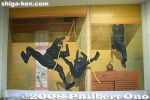
Ninja painting in Koka Station.
|
|
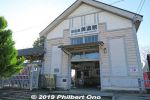
Mino Station on the old Meitetsu Mino-cho Line in Gifu Prefecture closed in April 1999 and has been preserved as a Registered Tangible Cultural Property (登録有形文化財) since 2005. The train line was abolished in March 1999. However, the charming station building still stands and open to the public, complete with a few trains on display. Mino Station first opened here in Oct. 1923. (Not to be confused with other Mino Stations in Japan.) Short walk from Minoshi Station (美濃市駅) on the Nagaragawa Railway. 名鉄美濃町線
|
|

Mino Station ticket office.
|
|
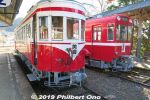
Mo 512 and Mo 601 trains.モ512およびモ601
|
|
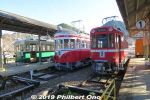
Mino Station, Gifu, with three retired trains on display.
|
|
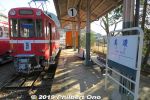
Mino Station, Gifu. モ601
|
|

Nagoyajo subway station on the Meijo subway line. Nagoya Castle is near Nagoyajo Station (used to be named "Shiyakusho") which is also near Nagoya's city hall. This station exit has a castle motif.
|
|

The new JR Nagahama Station opened in Oct. 2006.
|
|

Outside on the terrace facing south at Nagahama Station. The small waiting room has been removed and replaced by a walkway to the new Mondecool Heiwado store.
|
|

Built in 1882 as Nagahama Station's first station building. Nagahama Railroad Square 旧長浜駅舎 MAP
|
|

Nagahara Station on the JR Kosei Line. A nice, loghouse station building. JR湖西線、永原駅
|
|
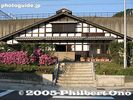
Omi-Shiotsu Station JR近江塩津駅
|
|
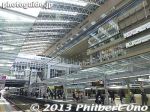
JR Osaka Station's new terminal building opened on May 4, 2011. Great improvement. It has a simple lean-to roof that creates some space to build bridges and plazas above the train tracks.Very easy to get your bearings and remember which way to go wherever you wanna go.
|
|
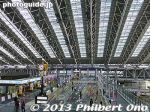
JR Osaka Station
|
|

By now, you will notice that the tanuki (racoon dog) is the symbol of Shigaraki. This giant tanuki greets you at Shigaraki Station. Wish they removed that pay phone.
|
|

On the Shigaraki Kogen Railway Line, get off at Shigaraki Station at the end of the line. 信楽駅
|
|

Shigaraki Kogen Railways Shigaraki Station. You can take a bus to reach Shigaraki Ceramic Cultural Park in 5 min., or walk for 20 min. 信楽駅
|
|

Giant tanuki at Shigaraki Station. Wish they removed that pay phone.
|
|

Inside Sendai Station's west side. A great greeting for visitors to Sendai during Tanabata Matsuri.
|
|

In Sendai, famous daimyo Date Masamune had the warrior and merchant classes observe the Star Festival.
|
|

Takamiya-juku was the sixty-fourth of the sixty-nine stations or shukuba post towns of the Nakasendo Road. Today, it has a few remnants of its Nakasendo past with a Honjin gate, Enshoji temple (where Emperor Meiji once stayed), and shrines.Ohmi Railways Takamiya Station. Looks like a shrine. 近江鉄道 高宮駅
|
|

Opened in 1914, Tokyo Station is Japan's main train station and has been undergoing major renovations. The red brick station building on the Marunouchi side has been restored with the original roof domes.
|
|
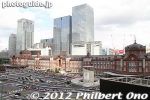
The new Tokyo Station with original domes restored. See more before and after photos below.
|
|
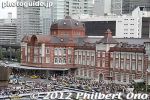
Tokyo Station, Marunouchi North Entrance dome in Oct. 2012.
|
|

Tokyo Station Marunouchi South Entrance dome in Oct. 2012.
|
|
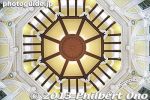
Tokyo Station Marunouchi South Entrance dome in Oct. 2012.
|
|

When you arrive JR Toyooka Station, you will soon notice that the Oriental white stork ("kounotori" in Japanese) is the symbol of the city. Even the roof looks like a soaring bird.
|
|

Yamanaka-dani Station is lined with 1,000 cherry trees on both sides of the track. They bloom in early April.
|
|

Yamanaka-dani Station is one of the most beautiful train stations in spring. It is also the least busy station on the Hanwa Line.
|
|

Yamagata Station's exit has hanagasa (flower hat) decorations.
|
|
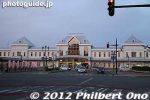
JR Yonezawa Station in spring.
|
|
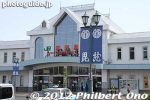
JR Yonezawa Station in spring.
|
|
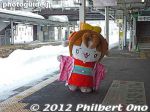
JR Yonezawa Station
|
|
|
|
|
|
|